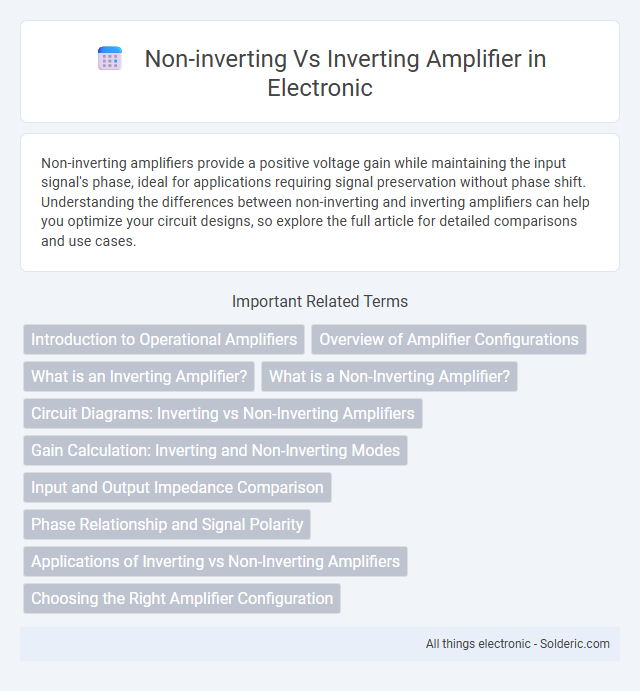Non-inverting amplifiers provide a positive voltage gain while maintaining the input signal's phase, ideal for applications requiring signal preservation without phase shift. Understanding the differences between non-inverting and inverting amplifiers can help you optimize your circuit designs, so explore the full article for detailed comparisons and use cases.
Comparison Table
| Feature | Non-Inverting Amplifier | Inverting Amplifier |
|---|---|---|
| Input Signal Phase | Output in-phase with input | Output inverted (180deg out of phase) |
| Input Impedance | Very high (ideal: infinite) | Lower (determined by input resistor) |
| Voltage Gain Formula | 1 + (Rf / Rin) | -(Rf / Rin) |
| Output Impedance | Low | Low |
| Common Use | Buffer, signal amplification without phase shift | Signal inversion and amplification |
| Typical Application | Voltage followers, sensor signal conditioning | Analog computation, summing amplifiers |
Introduction to Operational Amplifiers
Operational amplifiers (op-amps) are fundamental components in analog electronics, designed to amplify voltage signals with high gain and stability. Non-inverting amplifiers provide output signals in phase with the input, offering high input impedance and useful voltage amplification, while inverting amplifiers invert the input signal phase and offer precise gain control with low input impedance. Your choice between non-inverting and inverting configurations depends on the desired signal phase, input impedance, and gain requirements in the circuit design.
Overview of Amplifier Configurations
Non-inverting and inverting amplifiers are fundamental operational amplifier configurations used in signal processing and electronics. Non-inverting amplifiers provide a positive voltage gain with the input signal applied to the non-inverting terminal, resulting in output signals that are in phase with the input. In contrast, inverting amplifiers apply the input signal to the inverting terminal, producing an output that is 180 degrees out of phase with the input, allowing for precise control of gain and signal inversion in your circuit designs.
What is an Inverting Amplifier?
An inverting amplifier is an operational amplifier configuration where the input signal is applied to the inverting (-) terminal, resulting in an output signal that is 180 degrees out of phase with the input. This configuration provides a gain determined by the ratio of feedback resistor to input resistor, allowing precise control of signal amplification with negative feedback. Your circuit benefits from predictable voltage gain and phase inversion, making inverting amplifiers essential in mathematical operations and audio applications.
What is a Non-Inverting Amplifier?
A non-inverting amplifier is an operational amplifier configuration where the input signal is applied to the non-inverting terminal, resulting in an output signal that is in phase with the input. It provides a high input impedance and a voltage gain greater than or equal to one, depending on the feedback resistor network. This configuration is widely used in applications requiring signal buffering and amplification without signal inversion.
Circuit Diagrams: Inverting vs Non-Inverting Amplifiers
Inverting amplifier circuit diagrams feature the input signal applied to the inverting input terminal through a resistor, with the non-inverting input connected to ground, creating a phase-inverted output. Non-inverting amplifier circuits connect the input signal directly to the non-inverting terminal, while the inverting terminal is tied to a feedback network that stabilizes gain without phase inversion. Understanding your specific gain and phase requirements determines which amplifier configuration best suits your design needs.
Gain Calculation: Inverting and Non-Inverting Modes
Gain calculation in an inverting amplifier is determined by the ratio of the feedback resistor to the input resistor, resulting in a gain formula of -Rf/Rin, indicating signal inversion and amplification. In contrast, the non-inverting amplifier's gain is calculated using 1 + (Rf/Rin), providing amplification without phase inversion. Understanding these formulas helps you design circuits with desired signal amplitude and phase characteristics effectively.
Input and Output Impedance Comparison
Non-inverting amplifiers present a high input impedance, typically in the megaohms range, which minimizes signal source loading and preserves signal integrity. Inverting amplifiers feature a lower input impedance, usually equal to the input resistor value, often in the kiloohms range, causing more loading on the signal source. Output impedance for both amplifier types is generally low, usually below 100 ohms, ensuring effective driving of loads without significant voltage drop.
Phase Relationship and Signal Polarity
Non-inverting amplifiers maintain the same phase between the input and output signals, ensuring your output voltage is in phase with the input, preserving signal polarity. In contrast, inverting amplifiers produce an output signal that is 180 degrees out of phase, effectively flipping the signal polarity. Understanding this phase relationship is crucial when designing circuits that require precise signal alignment or polarity inversion.
Applications of Inverting vs Non-Inverting Amplifiers
Inverting amplifiers are widely used in signal processing applications where phase inversion and precise gain control are essential, such as audio mixing and active filters. Non-inverting amplifiers find applications in sensor signal conditioning and buffering because they maintain the input signal phase and provide high input impedance. Your choice between inverting and non-inverting amplifiers depends on the need for signal phase integrity or inversion along with the specific gain and input impedance requirements of your circuit.
Choosing the Right Amplifier Configuration
Selecting the right amplifier configuration depends on the desired input impedance, phase relationship, and gain stability. Non-inverting amplifiers offer high input impedance and preserve signal phase, making them ideal for buffer stages and sensor signal conditioning. Inverting amplifiers provide precise gain control with a lower input impedance and a 180-degree phase shift, suitable for signal mixing and summing applications.
non-inverting vs inverting amplifier Infographic

 solderic.com
solderic.com